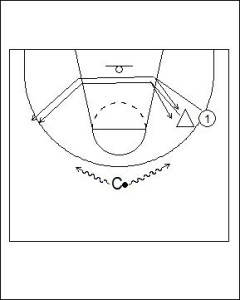Contesting Drill – Overplay
The Contesting Drill helps defenders develop the ability to blend playing high-pressure denial defence with the ability to also defend the back cut.

In the Contesting Drill the coach starts with the ball. The coach can dribble to either side attempting to create a passing lane.
One (1) attempts to create lead for the ball and receive a pass from the coach.
The defender overplays one (1) to deny the pass.
One (1) can go backdoor: defender moves into open stance and resumes closed stance when One (1) goes to weak side wing.
The challenge for the defensive player is to deny the pass to One (1), but not allow the backdoor cut option.
Once One (1) receives the pass the Contesting Drill becomes a one on one situation.
The Contesting Drill looks to improve game specific footwork while also helping players with their position and ability to apply pressure.
Points of Emphasis
- Split vision
- 1/3 distance between ball and man
- Denial stance
- Open up when losing vision
- Close out if you don’t get to deny
Variation
The range of movement the offensive player has will prove to be very challenging for the defensive player. One option to simplify the drill initially is to restrict the amount of court the offensive player has to move within. For example, a coach can instruct the offensive player to only use one side of the court. This will make it easier for the defensive player to recover and play defence in general.
The principle focus of the Contesting Drill is for the defensive player to have to cover the full width of the court and change defensive stance and technique. So try to move quickly through this reduction in court space to the full use of the half court for the offensive player.
There are a few different options that can be implemented within the Contesting Drill to increase the challenge.
The first suggested option is to replace the coach with a player. This will help passers with their reads in regards to when to make, and not make a pass to a teammate.
To further this scenario a defender can be added to the passer and then the pass must be made and received under pressure from all angles.
Another option to vary the challenge of the Contesting Drill is to add another set of defender and offensive player. Players will then have to negotiate another player on the court. Again, as soon as one of the offensive players receives a pass the drill will become a two on two situation.
In the two on two scenario it is important for the defensive player off the ball to move into a help position as soon as possible. This will be a very important aspect of the activity for those teams who engage in high-pressure denial defences.
The breakdown in a pressure defence often results in the offensive player involved becoming a scorer. Therefore simulating a pressure defensive situation, which then leads into help defence, is of big value.
The Contesting Drill is easy to implement. Nevertheless, is a highly challenging drill. Time will be needed to perfect the technique of changing from denying the pass on the perimeter to defending the back cut and then rotating to the opposite side of the floor. A coach will need to be patient, but persistent.








Leave a Reply